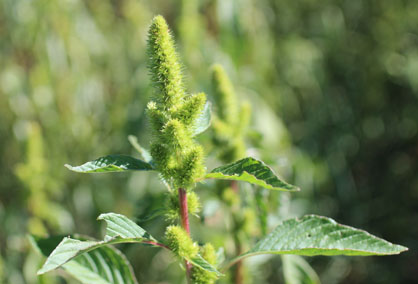
Location
On trail incline around #9 (N35D33'01.739 X W105D41'19.008)
Flowers first observed: 8/16/17
The Plant w/Flowers
The Flowers

Distribution
"Redroot pigweed and smooth pigweed are native to North America and Central America, occurring as pioneer plants of riparian regions, while Powell amaranth is native to dry, mountainous regions in the southwestern United States and Mexico" (Extension)
Description
"Amaranthus retroflexus, true to one of its common names, forms a tumbleweed.[3] It is native to the tropical Americas, but is widespread as an introduced species on most continents in a great number of habitats. This is an erect, annual herb reaching a maximum height near 3 m (9.8 ft). The leaves are nearly 15 cm (5.9 in) long on large individuals, the ones higher on the stem having a lance shape and those lower on the plant diamond or oval in shape. The plant is monoecious, with individuals bearing both male and female flowers. The inflorescence is a large, dense cluster of flowers interspersed with spiny green bracts. The fruit is a capsule less than 2 mm (0.079 in) long with a "lid" which opens to reveal a tiny black seed. Another of A. retroflexus's common names is pigweed because it grows where hogs are pasture-fed." (Wikipedia)
"The distinctly red or pink taproot and lower stem for which redroot pigweed was named is not a definitive characteristic of this species, as other Amaranthus species, including smooth pigweed and Powell amaranth, sometimes show similar coloration. (Extension)
Ethnobotanical Uses
Food:
"This plant is eaten as a vegetable in different places of the world. No species of genus Amaranthus is known to be poisonous,[4] but the leaves contain oxalic acidand may contain nitrates if grown in nitrate-rich soils, so the water should be discarded after boiling.
A. retroflexus was used for a multitude of food and medicinal purposes by many Native American groups.[5] It is among the species consumed as a vegetable in Mexican markets as Quelite quintonil.
It is used in the Indian state of Kerala to prepare a popular dish known as thoranby combining the finely cut leaves with grated coconut, chili peppers, garlic, turmeric and other ingredients.
The seeds are edible raw or toasted, and can be ground into flour and used for bread, hot cereal, or as a thickener.[6]" (Wikipedia)
Internet Links
